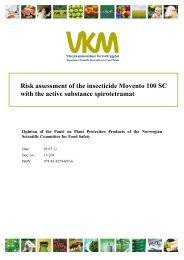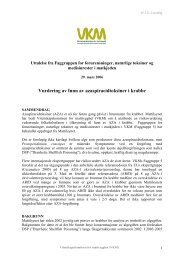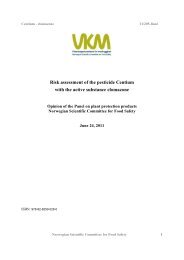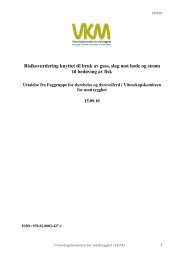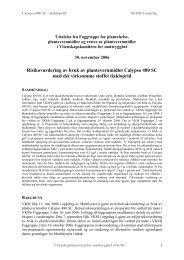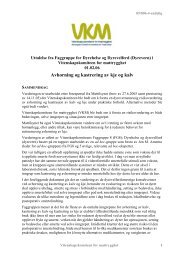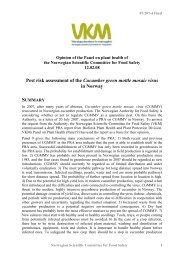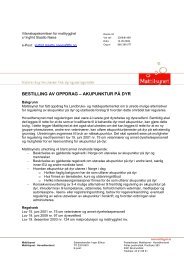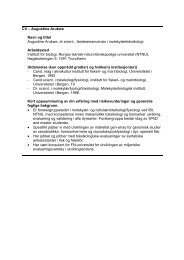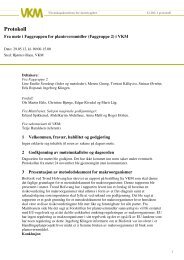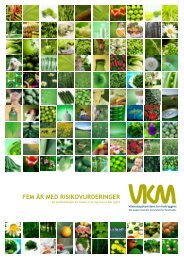Risikovurdering ved import av tropiske reker fra Hawaii for oppdrett i
Risikovurdering ved import av tropiske reker fra Hawaii for oppdrett i
Risikovurdering ved import av tropiske reker fra Hawaii for oppdrett i
Create successful ePaper yourself
Turn your PDF publications into a flip-book with our unique Google optimized e-Paper software.
13. Referanser<br />
1. Aloha Shrimp Company (2005). – Products and services, SPF Litopenaeus vannamei.<br />
http://www.alohashrimp.com/pages/products.htm. 13.12.2005.<br />
2. Anderson T., Law A. T., Sharif M. & Nash G. (1990). – A parvo-like virus in the giant freshwater<br />
prawn, Macrobranchius rosenbergii. J. Invert. Pathol. 55 447-449.<br />
3. Anonymous (1997). An evaluation of potential shrimp virus impacts on cultured shrimp and wild<br />
shrimp populations in the Gulf of Mexico and Southeastern U.S. Atlantic coastal waters. A report<br />
to the joint subcommittee on aquaculture, prepared by the JSA shrimp virus work group. 65 pp.<br />
4. Anonymous. (2000). – Prawns and Prawn products <strong>import</strong> risk analysis, Draft report, August 2000,<br />
AQIS, 185 pp.<br />
5. Anonymous. (2005). – Taura Syndrome. http://nas.nfrcg.gov 17.6.2005.<br />
6. Ass<strong>av</strong>alapsakul W., Smith D. R. & Panyim S. (2003). – Propagation of infectious yellowhead virus<br />
particles prior to cytopathic effect in primary lymphoid cell cultures of Penaeus monodon. Dis.<br />
Aquat. Org. 55, 253-258.<br />
7. Bell T. A. & Lightner D. V. (1984). – IHHN virus: infectivity and pathogenicity studies in P.<br />
stylirostris and P. vannamei. Aquaculture. 38, 185-194.<br />
8. Bonami J. R., Lightner D. V., Redman R. M. & Poulos B. T. (1992). – Partial characterization of a<br />
tog<strong>av</strong>irus (LOVV) associated with histopathological changes of the lymphoid organ of penaeid<br />
shrimps. Dis Aquat. Org. 14, 145-152.<br />
9. Bondad-Reantso M. G., McGladdery S. E., East I. & Subasinghe R. (2001). – Asia diagnostic guide<br />
to Aquatic Animal Diseses. FAO Fisheries Technical Paper 402, Suppl. 2, FAO Rome, Italy 240 pp.<br />
10. Briggs M., Funge-Smith S., Subasinghe R. & Phillips M. (2004). - Introductions and movement of<br />
Penaeus vannamei and Penaeus stylirostris in Asia and Pacific. RAP Publication 2004/10. FAO,<br />
Regional Office <strong>for</strong> Asia and the Pacific, Bankok. 92 pp.<br />
11. Bright Sing I. S., Manjusha M., Somnath Pai S. & Phillip R. (2005). – Fenneropenaeus indicus is<br />
protected from white spot disease by oral administration of inactivated white spot syndrome<br />
virus. Dis. Aquat. Org. 66, 265-270.<br />
12. Briñez B., Aranguren F. & Salazar M. (2003). – Fecal samples as DNA source <strong>for</strong> the diagnosis of<br />
necrotizing hepatopancreatitis (NHP) in Penaeus vannamei broodstock. Dis. Aquat. Org. 55, 69-<br />
72.<br />
13. Brock J. A. (1997). – Special topic review: Taura syndrome, a disease <strong>import</strong>ant to shrimp farms<br />
in the Americas. World J. Microbiol. % Technol. 13, 415-418.<br />
14. Brock J. A., Gose R., Lightner D. V. & Hasson K. W. (1995). – An overview on Taura Syndrome, an<br />
<strong>import</strong>ant disease of farmed Penaeus vannamei. In: Swimming through troubled water. Proc.<br />
Spec Session on shrimp farming, Aquaculture. C. Browdy & J. S. Hopkins (eds). World<br />
Aquaculture Society, Baton Rouge, LA, USA, 84-94.<br />
15. Brock J. A. & Maine K. (1994). – A guide to the common problems and diseases of cultured<br />
Penaeus vannamei. Oceanic Institute, Makapuu Point, PO Box 25280, Honolulu, <strong>Hawaii</strong>, USA. 241<br />
pp.<br />
16. Catap E. S., L<strong>av</strong>illa-Pitogo C. R., Maeno Y. & Tr<strong>av</strong>iña R. D. (2003). – Occurrence, histopathology<br />
and experimental transmission of hepatopancreatic parvovirus infection in Penaeus monodon<br />
postlarvae. Dis. Aquat. Org. 57, 11-17.<br />
17. Chang C.F., Su M.S., Chen H.Y. & Liao I.C. (2003). Dietary beta-1,3-glucan effectively improves<br />
immunity and survival of Penaeus monodon challenged with white spot syndrome virus. Fish<br />
Shellfish Immunol. 15 (4), 297–310.<br />
18. Chang Y.S., Lo C.F., Peng S.E., Liu K.F., Wang C.H. & Kou G.H. (2002). White spot syndrome<br />
virus (WSSV) PCR-positive Artemia cysts yield PCR-negative nauplii that fail to transmit WSSV<br />
when fed to shrimp postlarvae. Dis. Aquat. Org. 49 (1), 1–10.<br />
19. Chang P. S., Lo C. F., Wang Y. C. & Kou G. H. (1996). – Identification of white spot syndrome<br />
associated baculovirus (WSB) target organs in the shrimp Penaeus monodon by in situ<br />
hybridiszation. Dis Aquat. Org. 27, 131-139.<br />
20. Chantanachookin c., Boonyaratpalin S., Kasornchandra J., Direkbusarakom S., Aekpanithanpong<br />
U., Supamattaya K., Sriuraittana S. & Flegel T. W. (1993). – Histology and ultrastructure reveal a<br />
new granulosis-like virus in Penaeus monodon affected by yellowhead disease. Dis. Aquat. Org.<br />
36, 153-157.<br />
BSurvE · Veterinærinstituttet 78



